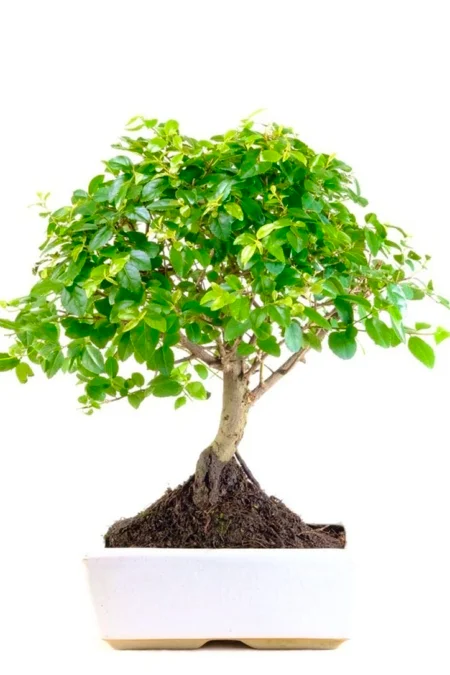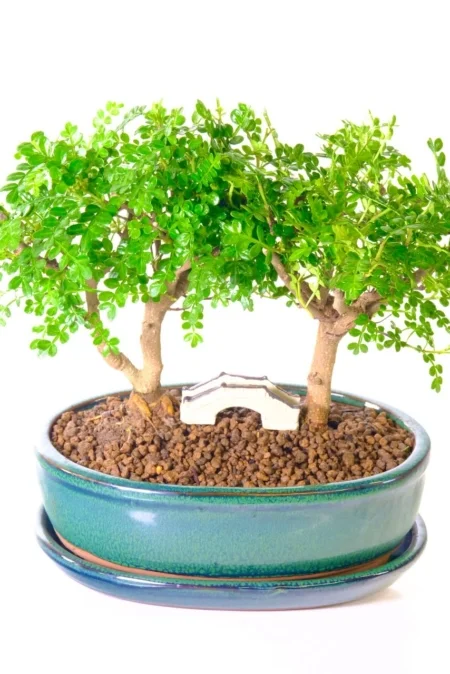The Perfect All Year Round Bonsai
Evergreen bonsai creating all year round interest.
One of the many reasons that one may choose to purchase a bonsai as an interior house plant is that most of them are evergreen. This means that they grow leaves all year round and do not enter a dormancy period. Evergreen bonsai create an all year round interest, they will bring a small part of nature into your home even through the winter months. A bonsai tree is a relaxing and artistic addition to ones home. It not only only brings some fresh life into your room, it also brings some creativity and air purifying qualities. Evergreen bonsai grow faster during spring and early summer months. During this period it is fun to prune and style your little tree.
Indoor Varieties.
The Chinese Elm is a very hardy variety and perfect for beginners. These trees can actually live inside or outside and can cope with temperatures down to around -5oc; they will become deciduous (lose their leaves) if kept outdoors. They display rich green serrated leaves on beautifully shaped trunks.
The Miniature Jade is an extremely easy to care for variety. The leaves are distinctive and shaped like little gems; they are fresh and vibrant in colour. These trees are fantastic for children and beginners as they require minimal watering.
The Aromatic Pepper is a fragrant variety. These trees release a fresh, zesty fragrance when pruned; it can fill a room! The leaves are incredibly rich in colour and they are uniquely shaped.
The Ficus Retusa is a captivating variety. The leaves are rich and multi-toned, they are typically large in size. The twisty trunks display beautiful striations and aerial roots.
Indoor Fruiting and Flowering Varieties.
The Oriental Tea Tree is an elegant variety. They display glossy, rich green leaves which grow dainty white flowers in the summer months. The trunks are a cream colour with lovely texture throughout and there are often exposed roots at the base.
The Chinese Sweet Plum is a wonderful variety. The fresh foliage will grow tips with red/tan colours in warmer months; the purple plum-like fruits will grow in summer too . These trees are recognisable by their characteristic, flaky trunks.
The Tree of a Thousand Stars / Snowrose is a lovely variety with unique leaf shape. The vibrant leaves are pointy and shaped like clusters of stars; the foliage canopy will display an abundance of delicate white flowers throughout summer. These trees have creamy bark and highly artistic root structure.
The Roseapple / Myrtle is a delightful variety with red-toned bark. In warmer months, the canopy will display cream flowers and blush red tips followed by cherry-like fruits in Autumn.
To summarise, if you are looking for a scented tree to add a calm aroma to your space, or a flowering tree to add a pop of colour; these indoor trees display different characteristics and symbolise beautiful meanings. Every tree we sell will be delivered in a pot, we have a beautiful range of colours. If you are looking for something truly special, we highly recommend you check out our premium range. Our premium indoor bonsai tree collection features our very best in quality bonsai. They are individually photographed and supplied with matching ceramic drip trays.
Our Top Selling All Year Round Evergreen Bonsai Tree Range for Indoors.
-
 Special Offer Beginners Indoor Bonsai ~ Chinese Elm 12 years old [FREE Delivery]Product on sale£54.99 – £61.98
Special Offer Beginners Indoor Bonsai ~ Chinese Elm 12 years old [FREE Delivery]Product on sale£54.99 – £61.98 -
 Outstanding Bonsai Offer – Twisty Bonsai Kit | Flowering Starter Kit for Beginners – CURRENTLY A LARGER BONSAIProduct on sale£69.99
Outstanding Bonsai Offer – Twisty Bonsai Kit | Flowering Starter Kit for Beginners – CURRENTLY A LARGER BONSAIProduct on sale£69.99 -
 Special Offer 8 year old Twisty S-Shaped Indoor Bonsai ~ Chinese Elm – Beginner’s Favourite£44.99
Special Offer 8 year old Twisty S-Shaped Indoor Bonsai ~ Chinese Elm – Beginner’s Favourite£44.99 -
 CURRENTLY CHINESE ELM | Special Offer Fukien Tea Tree (Carmona microphylla) – White Summer Flowers£39.99 – £45.98
CURRENTLY CHINESE ELM | Special Offer Fukien Tea Tree (Carmona microphylla) – White Summer Flowers£39.99 – £45.98 -
 Outstanding Medium Twisty Flowering Tea Tree Bonsai Kit – Choose your watering can!Product on sale£76.99
Outstanding Medium Twisty Flowering Tea Tree Bonsai Kit – Choose your watering can!Product on sale£76.99 -
 Flowering Baby Bonsai Tree with Drip TrayProduct on sale£33.99
Flowering Baby Bonsai Tree with Drip TrayProduct on sale£33.99 -
 Chinese Elm Bonsai Starter Pack – 12 years | Medium SizeProduct on sale£75.99
Chinese Elm Bonsai Starter Pack – 12 years | Medium SizeProduct on sale£75.99 -
 Chinese Elm ~ Indoor Bonsai [Best Bonsai Tree for Beginners]£59.99
Chinese Elm ~ Indoor Bonsai [Best Bonsai Tree for Beginners]£59.99 -
 Comprehensive Beginners Baby Bonsai Set£49.49
Comprehensive Beginners Baby Bonsai Set£49.49 -
 Enchanting Chinese Sweet Plum Bonsai: A Delightful Bonsai Bargain for BeginnersProduct on sale£35.99
Enchanting Chinese Sweet Plum Bonsai: A Delightful Bonsai Bargain for BeginnersProduct on sale£35.99 -
 Exemplary Beginners Chinese Elm Starter BonsaiProduct on sale£29.99
Exemplary Beginners Chinese Elm Starter BonsaiProduct on sale£29.99 -
 Flowering Oriental Tea Tree Bonsai Starter KitProduct on sale£59.99
Flowering Oriental Tea Tree Bonsai Starter KitProduct on sale£59.99
















































































































































